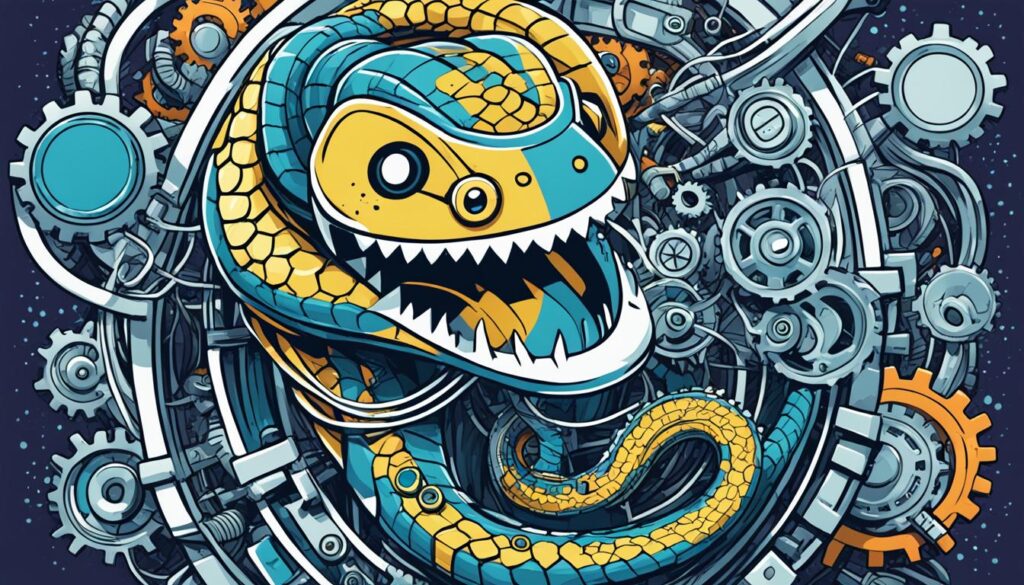In today’s digital landscape, chatbots have become increasingly prevalent, offering real-time customer support and automation across a variety of industries. By mastering the fundamentals of Python, developers can harness the power of natural language processing (NLP) to create intelligent, self-learning chatbots. This article will guide you through the essential skills required to build chatbots using Python, touching on topics such as natural language processing, machine learning, and deep learning.
Whether you’re a seasoned programmer or a newcomer to the field, this tutorial will provide you with the necessary tools and techniques to develop your own chatbot projects. From understanding the basics of the ChatterBot library to learning how to customize your chatbot’s responses, you’ll gain the knowledge and expertise to build engaging, user-friendly conversational agents. Additionally, we’ll explore the importance of data preparation and training, as well as the use of industry-specific data to enhance your chatbot’s performance.
By the end of this article, you’ll be equipped with the essential Python skills required to design and develop robust, intelligent chatbots that can streamline communication and deliver exceptional customer experiences. Join us on this exciting journey as we dive into the world of chatbot development and unlock the potential of Python in this rapidly evolving field.
Introduction to Chatbots and Natural Language Processing
Chatbots, powered by the advancements in natural language processing (NLP), have become increasingly prevalent in our digital landscape. NLP is a branch of artificial intelligence that empowers computers to understand, interpret, and respond to human language in a natural and intuitive manner. This technology is instrumental in enabling voice-guided GPS apps, virtual assistants, and other chatbots that offer real-time support and assistance.
What is Natural Language Processing (NLP)?
Natural language processing combines computational linguistics and intelligent algorithms to allow machines to rapidly process and respond to large volumes of text. By harnessing the power of language models, machine learning, and deep learning techniques, NLP enables computers to comprehend the nuances and contextual meanings of human speech and text.
Tasks in NLP
Key tasks in the realm of natural language processing include:
- Speech recognition: Converting spoken language into written text
- Word sense disambiguation: Determining the appropriate meaning of a word based on its context
- Named entity recognition: Identifying words and phrases as specific entities, such as people, organizations, or locations
- Sentiment analysis: Extracting emotions and undertones from human speech and text
These NLP capabilities are fundamental in powering the intelligent and responsive nature of modern chatbots, enabling them to engage in natural conversations and provide seamless user experiences.
“The ultimate goal of natural language processing is to read, decipher, understand, and make sense of the human languages in a manner that is valuable.” – Jürgen Schmidhuber, Pioneer in Deep Learning
Types of AI Chatbots
As the world of artificial intelligence continues to evolve, the landscape of chatbots has become increasingly diverse. Two distinct types of chatbots have emerged: scripted chatbots and artificially intelligent chatbots. Understanding the differences between these two approaches is crucial for businesses and developers looking to leverage chatbot technology effectively.
Scripted Chatbots
Scripted chatbots operate based on pre-determined scripts stored in their library. When a user inputs a query, the chatbot replies according to the predefined script within its library. This approach relies on string analysis and understanding to match user inputs with the appropriate response. One drawback of scripted chatbots is that users must structure their queries very precisely to facilitate this process, making it challenging to integrate these chatbots with natural language processing (NLP)-supported speech-to-text conversion modules.
Artificially Intelligent Chatbots
In contrast, artificially intelligent chatbots are designed to mimic human-like traits and responses. NLP plays a significant role in enabling these chatbots to understand the nuances and subtleties of human conversation. When NLP is combined with artificial intelligence, it results in truly intelligent chatbots capable of responding to nuanced questions and learning from each interaction to provide improved responses in the future. AI chatbots find applications in various platforms, including automated chat support and virtual assistants.
The choice between scripted chatbots and artificially intelligent chatbots depends on the specific needs and requirements of the business or application. While scripted chatbots may be more cost-effective and easier to implement, artificially intelligent chatbots offer a more natural and engaging user experience, particularly in situations where complex, context-sensitive conversations are required.
| Feature | Scripted Chatbots | Artificially Intelligent Chatbots |
|---|---|---|
| Conversational Ability | Limited to predefined scripts | Capable of natural, context-sensitive conversations |
| NLP Integration | Challenging to integrate with NLP-supported speech-to-text | Heavily reliant on NLP for understanding and responding to user inputs |
| Learning and Adaptation | Limited to predefined responses | Able to learn and improve responses based on user interactions |
| Applications | Simple customer service, FAQs | Automated chat support, virtual assistants |
By understanding the strengths and limitations of these two chatbot types, businesses can make informed decisions about which approach best aligns with their specific needs and goals, whether it’s the cost-effectiveness of scripted chatbots or the advanced conversational capabilities of artificially intelligent chatbots.
python required for building chatbots
When it comes to building chatbots, Python has emerged as a preferred choice for developers and programmers. Its simplicity, readability, and the vast array of libraries and tools available make it a powerful language for creating intelligent conversational agents.
Python’s strengths in the field of natural language processing (NLP) are particularly notable. Libraries like NLTK (Natural Language Toolkit) and spaCy provide developers with powerful tools for tasks such as text classification, sentiment analysis, and named entity recognition. These capabilities are essential for building chatbots that can understand and respond to human language effectively.
Moreover, Python’s extensive machine learning and deep learning libraries, such as TensorFlow and PyTorch, make it a preferred choice for developing chatbots that can learn and adapt over time. These technologies enable chatbots to engage in more natural and intelligent conversations, providing a more rewarding user experience.
One of the key advantages of using Python for chatbot development is the availability of specialized libraries like ChatterBot. This library simplifies the process of building conversational agents by providing pre-built components for dialogue management, intent recognition, and response generation.
- Python’s readability and simplicity make it an excellent choice for rapid prototyping and iterative development of chatbots.
- The wide range of NLP, machine learning, and deep learning libraries in Python empower developers to create highly intelligent and adaptive chatbots.
- Libraries like ChatterBot streamline the chatbot development process, allowing developers to focus on building the core functionality rather than reinventing the wheel.
In summary, Python’s versatility, powerful libraries, and widespread adoption in the programming community make it a preferred language for building chatbots. Its capabilities in natural language processing, machine learning, and deep learning provide the necessary tools for creating intelligent conversational agents that can engage with users in a natural and meaningful way.

Developing Your Own AI Chatbot Project
For beginners with no coding experience, no-code chatbot builders are a great place to start their chatbot development journey. These user-friendly platforms allow users to design conversational flows using a visual interface, drag-and-drop functionality, and pre-built elements. Some popular no-code chatbot builder options include Chatfuel, ManyChat, and Tidio.
On the other hand, for more advanced users seeking greater flexibility and customization, building a chatbot from scratch using code can be a rewarding experience. The general roadmap for creating a custom chatbot with Python includes defining the chatbot’s purpose, choosing the development method (no-code builder or coding), designing the conversation flow, training the chatbot with natural language processing and machine learning data, and continuously testing and refining it based on user interactions.
No-code Chatbot Builders
No-code chatbot builders are an excellent option for those new to chatbot development or with limited coding experience. These platforms simplify the process by providing a visual interface and pre-built components, allowing users to create engaging chatbots without delving into complex programming. By leveraging the drag-and-drop functionality and pre-designed templates, users can quickly build and deploy their chatbots, focusing on the conversation flow and user experience rather than the underlying deep learning algorithms.
Coding Your Own Chatbot with Python
For those with some programming expertise, building a custom chatbot from scratch using Python can be a rewarding and challenging endeavor. This approach offers greater control over the chatbot’s functionality, allowing for more advanced features and personalization. The process typically involves defining the chatbot’s purpose, designing the conversation flow, collecting and preprocessing relevant natural language processing data, and training the chatbot using machine learning algorithms to enhance its conversational abilities.
“Building a chatbot from scratch with Python allows for greater flexibility and customization, but it also requires a deeper understanding of programming and natural language processing techniques.”
Challenges in Creating AI Chatbots
Developing sophisticated AI chatbots that can truly understand and respond to human speech is a complex challenge that developers face. Overcoming these obstacles requires advanced natural language processing (NLP) techniques and continued improvements in language understanding algorithms.
One key hurdle is dealing with the nuances of human language, such as synonyms, homonyms, slang, misspellings, and complex punctuation rules. Chatbots must be able to interpret and make sense of these linguistic variations to have natural and meaningful conversations.
Additionally, differences in accents, dialects, and speech patterns across regions and cultures can make it difficult for chatbots to accurately recognize and comprehend speech. Perfecting speech recognition and language understanding is crucial for creating chatbots that can truly engage with users in a personalized and contextual way.
“The ultimate goal is to build chatbots that can understand the full depth and complexity of human communication, but that is a significant technical challenge that requires ongoing research and development in the field of natural language processing.”
Despite these challenges, advancements in areas like machine learning and deep learning are helping to drive progress in creating more intelligent and responsive chatbots. As these technologies continue to evolve, we can expect to see even more sophisticated and human-like AI conversational agents in the future.
Conclusion
Building chatbots with Python and natural language processing is a powerful way to create intelligent conversational agents that can interact with users in human-like ways. Whether you choose a no-code chatbot builder or code your own chatbot from scratch, leveraging Python’s libraries and tools for NLP, machine learning, and deep learning can help you develop engaging and responsive chatbots that can adapt and improve over time.
The key challenges in chatbot development, such as handling diverse speech patterns and language nuances, will continue to drive advancements in the field of artificial intelligence and natural language processing. As the technology evolves, businesses and developers can create more sophisticated Python-powered chatbots that provide seamless and personalized experiences for users across various industries and applications.
By mastering the essential skills in Python, natural language processing, and AI, you can unlock the full potential of chatbots and explore new frontiers in conversational interfaces and intelligent automation. The future of chatbots is promising, and with the right knowledge and tools, you can build innovative solutions that enhance user engagement, improve customer service, and drive business growth.
Source Links
- ChatterBot: Build a Chatbot With Python – Real Python – https://realpython.com/build-a-chatbot-python-chatterbot/
- Build Chatbots with Python | Codecademy – https://www.codecademy.com/learn/paths/build-chatbots-with-python
- How to Build Your AI Chatbot with NLP in Python? – https://www.analyticsvidhya.com/blog/2021/10/complete-guide-to-build-your-ai-chatbot-with-nlp-in-python/

[…] AI providers like OpenAI and Anthropic, delivering swift, high-quality translations. Conversations flow naturally, with no awkward pauses or […]